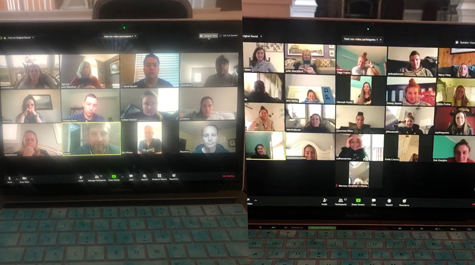William & Mary coaches adjust through communication and technology
Every coach deals with bumps along the road. Losing streaks, disciplinary issues, injuries to key personnel … those can be expected in any athletic season.
But no one could have foreseen, or given advice on how to handle, a global pandemic.
With COVID-19 a worldwide threat, William & Mary athletics is following the university's four principles: community safety, continuance of education, moving forward with business, and helping the global effort to end the spread.
Much of it will be done through technology, which is how W&M students will finish the school year. It's also how the Tribe's 18 head coaches and staff will stay in touch with their athletes.
Now, more than ever, communication will be essential.
After W&M suspended in-person classes and advised students to leave campus on March 11, step one became getting everyone home. For women's tennis coach Toni Bickford, who has five foreign players on her roster, that wasn't easy.
"It was challenging at first because a lot of them didn't really see how big an issue it would be to get home," Bickford said. "Once we convinced them of the urgency … they were eager to get home."
Mila Saric has returned to Spain, which has been hard hit by the virus. Bickford said Saric has stressed to her teammates the importance of staying home.
"It's a completely different perspective," Bickford said, "thinking about situations that are worse than we are."
Mostly through Zoom, coaches have scheduled regular meetings with their athletes. Keeping up with classes and staying in shape are stressed. But neither is No. 1 on the agenda.
"The first thing we talked about was the social responsibility that we all have," men's basketball coach Dane Fischer said. "We talked very frankly about from what you see, if any of us got it right now, most likely we'd be OK.
"But there are people who are contracting this who can't handle it. We have to take responsibility about doing our part not to spread this virus."
Football coach Mike London is taking the same approach.
"We have to make sure we continue to educate them to be cognizant that it's not just them," he said. "It's when they leave and go visit with other people, like the elderly population."
Alex Heacock, director of track and field and cross country, also emphasizes safety measures.
"Tommy Barrineau did a YouTube video on being a good citizen," Heacock said, referring to an assistant. "We've been trying to communicate the importance of social distancing. We all have stuff we need to get done but make sure we follow these parameters."
Though health is the biggest part of the message, with academics coming next, the coaches also are encouraging their athletes to remain active.
"Next week would have been when we started basketball workouts, but we're not telling our guys to go find a gym," Fischer said. "They've got to stay safe, and if they have a hoop at their house, they can do that. If not, we have to wait until this all passes."
Either way, the coach-athlete connection during workouts will be missing.
"The spring for us is a way to get kids who haven't played a lot to develop individually," women's soccer coach Julie Shackford said. "You lose that, but it also encourages them to find out how to make those goals happen on their own."
Women's basketball coach Ed Swanson agrees.
"The development piece of getting in the gym and working on their game with the coaches," Swanson said, "that's going to be the big unknown."
More than any sport, football emphasizes size and strength. But with most gyms closed, any weight-lifting program is problematic.
"That's a challenge, but we're going to respond to it in a safe manner," London said. "Some of it has to do with running and agility and changing direction, so you don't need an enclosed area to do that."
Recruiting is another concern. The NCAA has banned in-person meetings until at least April 15. All AAU events, including men's and women's basketball tournaments, were canceled.
"There's a little bit of a holding pattern," said Fischer, who has two remaining scholarships for next season. "Most kids are going to want to come see the place, and we're going to want to have a kid come here and spend time with him."
Bickford is working her phone and laptop.
"Now that we're sheltering at home, we have a lot more time to make phone calls to recruits," she said. "I've been doing a lot of recruiting, just not physical recruiting and traveling."
With the lockdowns and/or social distancing has come plenty of unexpected free time. Here's how the coaches are handling it:
Shackford, who is married and has three teenage children at home: "I'm making some great dinners. That's been fun, to have the whole family together for dinner. We very rarely get to eat together. And I started a class at Yale called the Science of Well-Being."
Bickford, married with a 5-year-old son: "We get in the backyard and try to do a lot of different sports. He loves football and soccer and we try to hit some tennis balls. And we have a routine of doing schoolwork, so after I get off the phone, I'm going to get him to do some math and reading."
Heacock, married with three children between the ages of 2 and 7: "I'm taking on the role of educator here. It's been fun and entertaining. This time of year, I'm usually gone two days a week. The ability to be home on the weekends in the spring is something I've never had."
Fischer, married with two small children: "This morning, I was telling my daughter wolf and monster stories for about 30 minutes per her request. My storytelling, I don't know if it's getting better, but it's getting more practice."
 Skip to main content
Skip to main content

